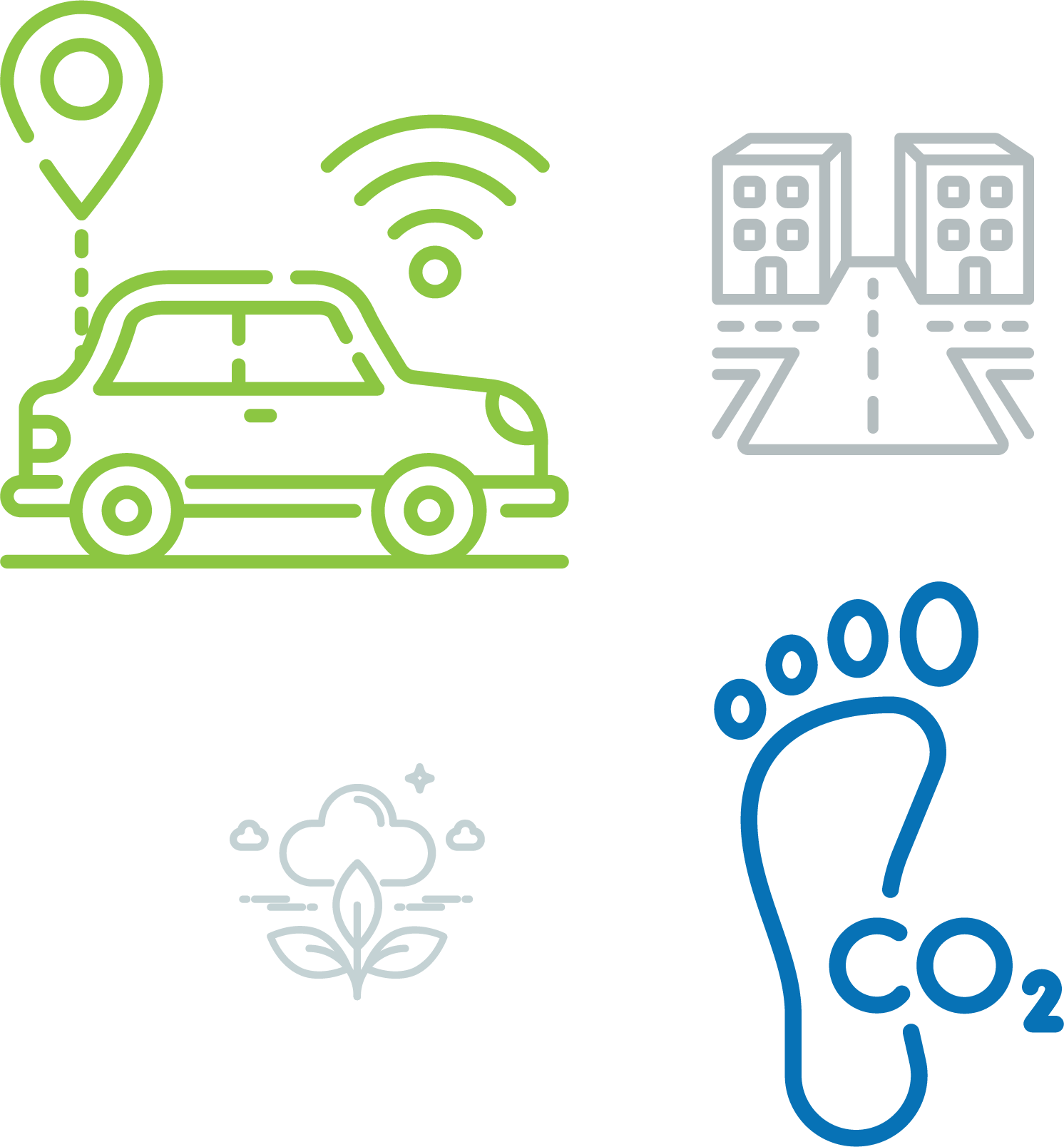Smart Mobility is an approach that aims to make transportation in cities more efficient, sustainable and user-friendly by using technology and innovative solutions. By integrating the use of digital tools and data, it optimizes the flow of traffic, reduces environmental impacts and improves the transport experience.
Smart transportation includes solutions such as real-time traffic management, shared transportation platforms and electric/autonomous vehicles. These systems enable better coordination of transportation services and promote sustainable transportation options such as public transport, cycling and walking in cities. They also make different modes of transportation a seamless experience, with applications such as Mobility as a Service (MaaS), where transportation services are offered through a single platform.
In line with Istanbul’s Sustainable Urban Transport Plan (SKUP), smart transportation aims to reduce private car dependency, lower carbon emissions and improve air quality in the city. This innovative approach offers both environmentally friendly solutions and improves the city’s quality of life.
Mobility as a Service (MaaS) is a transformative approach that integrates multiple transportation options such as bus, train, car sharing and bike rental into a single, easy-to-use digital platform. MaaS enhances user convenience and promotes efficient travel by enabling seamless planning, booking and payment through a single app. This system supports sustainable mobility by promoting the use of diverse, environmentally friendly modes of transportation, reducing reliance on personal vehicles and lowering overall carbon emissions. MaaS is a key player in the creation of smarter, greener urban transportation solutions.
Resilience refers to the ability of systems, cities or communities to withstand, recover and adapt to sudden shocks and long-term stresses. This includes being able to cope with unexpected events such as natural disasters, climate change and economic crises. In sustainable urbanism, resilience means ensuring that cities are prepared for such challenges and can recover quickly.
International organizations such as the United Nations and the European Commission see resilience as an essential element of sustainable development. This involves cities strengthening their infrastructure, reducing risks and increasing their capacity to adapt to future changes.
In the context of Istanbul’s sustainable urban transport objectives, resilience encompasses measures to ensure that transport systems can cope with both sudden events (e.g. extreme weather) and long-term challenges (population growth, resource scarcity). A resilient transport system, supported by strong infrastructure investments, diversified transport options and smart technologies, is critical to maintain the city’s functionality and citizens’ well-being.
Low Emission Zones (LEZ) are areas in cities where the entry of certain vehicles is restricted or prohibited in order to reduce air pollution. Vehicles that emit high levels of pollutants cannot enter these zones or can do so by paying an additional fee. This practice aims to reduce the negative impacts of air pollution on human health and the environment by encouraging the use of cleaner and more environmentally friendly vehicles.
Low emission zones, which are widely used in Europe, have been introduced specifically for the purposes of sustainable urban transportation and improving air quality. These zones reduce harmful emissions from motor vehicles and provide cleaner air and a healthier living environment in cities.
LEZ applications encourage the use of greener vehicles such as electric or hybrid vehicles and encourage people to use more sustainable transportation alternatives such as public transport, walking and cycling. In this way, cities become more sensitive to both the environment and human health, and an important step is taken in the fight against climate change.
Accessibility means that every individual, regardless of age, physical condition or socio-economic status, can easily reach basic services, opportunities and destinations. Accessibility in urban transport ensures that everyone has equal access to public transportation, safe pedestrian and bicycle routes. It is especially important to consider the needs of people with disabilities, the elderly and other vulnerable groups.
This concept is a key component of sustainable development and is emphasized in the United Nations Sustainable Development Goals (SDGs) and the European Commission’s urban transport policies. Accessibility is not limited to the availability of transportation services; it also requires that these services are safe, affordable and available to all individuals.
In the context of the Sustainable Urban Transport Plan (SUDP), accessibility aims to create integrated transport networks in cities where everyone can move freely. This will reduce social inequalities, improve quality of life and make big cities like Istanbul more livable for everyone.
Carbon Footprint refers to the total amount of greenhouse gases released into the atmosphere as a result of the activities of a person, organization or city. This value, which is usually measured in tons, is affected by many factors such as the energy we use in our daily lives, our modes of transportation, and our consumption habits. The size of the carbon footprint shows how much we contribute to climate change.
Reducing carbon footprint is a key element in sustainable development and combating climate change. Many international organizations, notably the United Nations and the European Commission, have set targets for reducing carbon footprints.
In urban transport, the carbon footprint of individuals and cities is highly dependent on the means of transportation used. Fossil fuel vehicles emit much more carbon emissions than alternatives such as public transportation, walking or cycling. Istanbul SDUP aims to reduce the city’s carbon footprint by strengthening public transportation systems, expanding walking and cycling routes, and promoting environmentally friendly transportation. In this way, Istanbul will be a cleaner, healthier and more livable city.
Carbon emissions are the release of carbon dioxide (CO₂) into the atmosphere, primarily from human activities. Major sources include burning fossil fuels such as coal, oil and gas for energy, deforestation that reduces the Earth’s ability to absorb CO₂, industrial processes such as cement production, and some agricultural practices. These emissions trap heat in the atmosphere, contributing to global warming, extreme weather events and environmental damage. Addressing and reducing carbon emissions, also with the help of sustainable transportation plans, is crucial to mitigating climate change and securing the future of our planet.
Urban Heat Island (UHI) is a phenomenon that causes cities to have higher temperatures than the surrounding countryside. Buildings, roads and other infrastructure in cities absorb and store heat from the sun, and these materials do not reflect heat back like natural environments. Concrete, asphalt and metal surfaces in particular collect the sun’s heat during the day and release it during the night, leading to high temperatures in cities.
One of the most important factors in this effect is the reduction of green spaces in cities. Trees and vegetation naturally cool the air through evaporation. But with increasing urbanization, this natural cooling mechanism is lost. At the same time, intensive energy use also increases the urban heat island effect. In particular, the continuous use of appliances such as air conditioners generates waste heat and further raises the temperatures of cities.
The Urban Heat Island effect can have serious consequences in cities. Increased energy consumption leads to more air conditioning and electricity demand, which puts pressure on energy infrastructure. Health risks also increase as temperatures rise, with heat-related illnesses becoming more common, especially for vulnerable groups such as the elderly and children. In addition, high temperatures worsen air pollution, as heat leads to an increase in pollutants such as ozone.
To reduce these negative impacts, sustainable solutions such as increasing green spaces in urban planning, using reflective roofing materials and better insulating buildings are gaining importance. These steps enable cities to retain less heat and make them more resilient and livable as part of strategies to combat climate change and climate adaptation.
Micro mobility refers to small, lightweight transportation options designed for short trips in urban environments. This category includes vehicles such as electric scooters, bicycles (both conventional and electric) and electric skateboards. These modes of transportation offer several advantages: they help reduce traffic congestion by using short distances efficiently, they generally have a lower environmental impact due to their electric nature, they are cost-effective compared to car ownership, and they provide convenience for quick commutes and last-mile connections. As an important element of modern urban transportation strategies, micromobility contributes to more efficient, sustainable and livable cities.
Net zero emissions refers to the situation where greenhouse gases emitted into the atmosphere are offset by their withdrawal, either naturally or through technological means. Achieving net zero means that a city, country or organization minimizes its carbon emissions and offsets the remaining emissions through methods such as reforestation or carbon capture.
This concept is supported by international frameworks such as the Paris Agreement to combat climate change. The aim is to limit global warming to no more than 2°C above pre-industrial levels, preferably 1.5°C. Achieving the net zero emission target, especially by 2050, is critical to prevent the negative impacts of climate change.
In the context of urban transportation, the net zero emission target is achieved by shifting to electric vehicles powered by clean energy, promoting active modes of transportation such as walking and cycling, and improving public transport systems. This approach not only reduces the carbon footprint, but also improves air quality in cities and promotes healthier living.
The concept of Healthy Streets aims to create accessible, safe and pleasant urban spaces that prioritize human health. This approach aims to expand pedestrian and bicycle routes and make public transportation the preferred mode of transportation. By reducing the use of private vehicles, it both improves the quality of life in the city and encourages a healthy lifestyle.
This approach, supported by organizations such as the World Health Organization (WHO) and Transport for London (TfL), aims to reduce health problems such as air pollution, sedentary life and traffic accidents in cities. Healthy Streets aims to make cities safer, greener and more accessible as part of a sustainable urban mobility approach.
The basic principles of this concept include clean air, safe crossings, shaded rest areas, reduction of traffic noise and promotion of social gathering spaces. It is a priority that people of all ages and abilities, especially children, the elderly and people with disabilities, can use the streets with ease. Healthy Streets contribute both to creating a sustainable city by reducing environmental impacts and improving the physical and mental health of city residents.
Strategic planning in urban planning is a forward-thinking approach that guides the growth and development of cities over the long term. It involves setting a shared vision for the future, analyzing current challenges and establishing specific goals to create a sustainable and livable urban environment. Through stakeholder engagement and actionable plans, strategic planning helps cities balance economic development, community needs and environmental sustainability. By carefully coordinating policies and projects, cities can adapt to changing conditions and ensure a higher quality of life for residents.
Sustainability refers to meeting today’s needs without compromising the ability of future generations to meet their own needs. The concept of sustainable development, based on the definition of the United Nations, aims to balance environmental, social and economic dimensions. This approach aims to ensure the long-term well-being of both people and the planet.
Sustainable urban transport refers to creating systems that reduce environmental impacts, improve quality of life and provide equal transportation opportunities for everyone. Supported by global organizations such as the European Commission, this approach reduces dependence on fossil fuels by prioritizing public transport, bicycle and pedestrian paths.
Within the framework of sustainable urbanization, these systems are integrated with green infrastructure, energy efficiency and smart land use. The aim is to build livable cities that are both environmentally friendly and socially inclusive in the long term.
Renewable energy utilizes natural resources such as sunlight, wind and water, which are constantly renewed and sustainable. By using these clean resources, we can significantly reduce greenhouse gas emissions and combat climate change. Integrating renewable energy into sustainable mobility solutions, such as electric public transport and bike-sharing programs, supports a greener future and improves urban livability. Embracing renewable energy is crucial for creating environmentally friendly transportation systems and advancing sustainability.
Green Infrastructure is a system of natural and semi-natural spaces that enhance environmental, social and economic benefits in cities by providing nature-based solutions. It includes elements such as parks, green roofs, urban forests, wetlands and stormwater management systems. By protecting ecosystems, green infrastructure helps cities combat climate change, tackle environmental problems such as flooding and improve air quality.
Highlighted by organizations such as the European Commission and the United Nations, this concept harnesses the power of nature to make cities more sustainable and livable. Green infrastructure plays a critical role in climate change adaptation and reducing carbon emissions.
Within the framework of sustainable transportation in Istanbul, green infrastructure creates nature-friendly transportation networks such as pedestrian paths, bicycle paths and green corridors, making transportation in the city environmentally compatible and providing a healthier and more enjoyable living space for citizens.
Shared Documents




